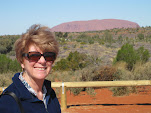Our first stop was Rano Raraku. It was the quarry for the Moai for the island. They were carved here then dragged (many different theories as to how they managed to do this) to various sites around the island. The Moai below (behind us) were in the process of being excavated and were never transported for various reasons.
The largest of the Moai are 23 meters. They have bottoms as well as tops, most of each statue is left underground to help preserve them.
There are two Moai in the photo above - one was in the process of being carved out of the rock when the carvers gave up.
Another view of the fallen and rejected Moai.
The Easter Islanders, after a very auspicious beginning, broke into 15 clans who then began to fight one against the other. The ultimate result of the civil war amongst the clans was they toppled over the Moai from each clan. The ones that are upright today have been re-set up to see what they looked like before the battles.
The Moai above is the only one who's in a kneeling position. The archeologists who uprighted the Moai decided to leave the bottom parts of them underground to keep them preserved. The weather, lichens, and all does real damage to them.
We then went up to the crater of the Rano Raraku volcano. There was a lake in it. The reeds around the lake which float on it are the only naturally occurring plant left on the island.
John and Charlie sitting near the lake. John told us about a native tri-athelon in this crater. 1st a canoe race across the water, 2nd carting 2 twenty kilo stones running around the lake, and 3rd ran up inside the caldera grabbed a paddle board and swam across the lake.
We then went to Ahu Tangariki (Ahu means platform - it's the stone platform that the Moai were meant to sit on)
John is showing Charlie the remains of the Rapa Nui house structures. Basically the size and shape of the canoes that brought them to the island - the roof looked like overturned canoes covered in grass. They were only used for sleeping.
The quarry from Ahu Tangariki
Charlie and John near a collapsed Moai - 15 standing Moai in the rear. The Moais actual direction was always away from the coast facing the people who lived near them - they eyes facing the stars
The 15 Moai behind us represent each of the 15 clans. An attempt at peace which apparently didn't work. These Moai were knocked over a 2nd time in a tsunami which occurred after the 1960 Chilean earthquake.
Next on our tour Aka Hanga. This was a site of a platform that was in the "original" condition after the warring clans got done knocking over each others Moai. In the platforms under each of the Moai are the bones of the person for whom the Moai was constructed. Apparently the bones have been taken from the platforms that have been reconstructed. The one below still has the bones remaining in it.
The site for the platforms had to have several basics: 1.) an inlet so they could get out and fish 2.) a raised hillside 3.) water and 4.) a cave - like the lava cave below - which was used for (among other things) a birthing chamber.
The inlet (and view) from Aka Hanga
Our last stop was Anakena. One of the two sandy beaches on Easter Island. The sand was amazing white, ground-up coral.
Souvenir stands and snack shops near the parking lot.
These Moai in the foreground were very well preserved. The thinking goes that they had been buried in the lovely sand and that kept them in great shape. The Moai in the background was uprighted by Thor Hyerdahl.
Charlie on the beach. We both went into the water. As John said, "It's fresh" AKA brrrrrrr.


















No comments:
Post a Comment